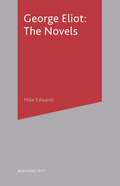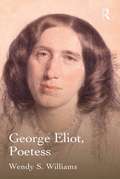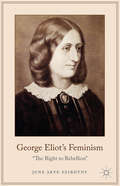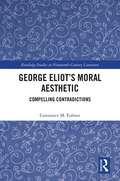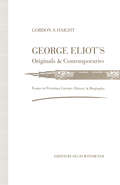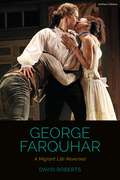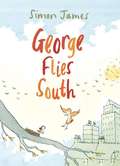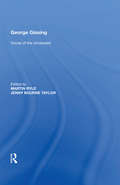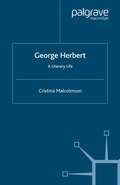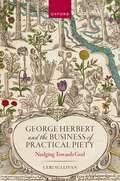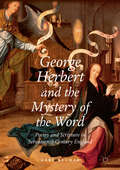- Table View
- List View
George Eliot: The Novels (Analysing Texts)
by Mike EdwardsThis volume guides students through Eliot's most widely studied novels: The Mill on the Floss, Silas Marner and Middlemarch. The first part of the book is based on analysis of extracts grouped by themes including relationships, society and morality. At the end of each chapter, a 'Methods' section offers ideas for independent study. The second part describes Eliot's biographical, cultural and intellectual environment, and gives readings of representative critical writing.
George Eliot, Poetess
by Wendy S. WilliamsThe position of George Eliot’s poetry within Victorian poetry and within her own canon is crucial for an accurate picture of the writer, as Wendy S. Williams shows in her in-depth examination of Eliot’s poetry and her role as poetess. Williams argues that even more clearly than her fiction, Eliot’s poetry reveals the development of her belief in sympathy as a replacement for orthodox religious views. With knowledge of the Bible and a firm understanding of society’s expectations for female authorship, Eliot consciously participated in a tradition of women poets who relied on feminine piety and poetry to help refine society through compassion and fellow-feeling. Williams examines Eliot’s poetry in relationship to her gender and sexual politics and her shifting religious beliefs, showing that Eliot’s views on gender and religion informed her adoption of the poetess persona. By taking into account Eliot’s poetess treatment of community and motherhood, Williams suggests, readers come to view her not only as a writer of fiction, an intellectual, and a social commentator, but also as a woman who longed to nurture, participate in, and foster human relationships.
George Eliot, Poetess
by Wendy S. WilliamsThe position of George Eliot’s poetry within Victorian poetry and within her own canon is crucial for an accurate picture of the writer, as Wendy S. Williams shows in her in-depth examination of Eliot’s poetry and her role as poetess. Williams argues that even more clearly than her fiction, Eliot’s poetry reveals the development of her belief in sympathy as a replacement for orthodox religious views. With knowledge of the Bible and a firm understanding of society’s expectations for female authorship, Eliot consciously participated in a tradition of women poets who relied on feminine piety and poetry to help refine society through compassion and fellow-feeling. Williams examines Eliot’s poetry in relationship to her gender and sexual politics and her shifting religious beliefs, showing that Eliot’s views on gender and religion informed her adoption of the poetess persona. By taking into account Eliot’s poetess treatment of community and motherhood, Williams suggests, readers come to view her not only as a writer of fiction, an intellectual, and a social commentator, but also as a woman who longed to nurture, participate in, and foster human relationships.
George Eliot: A Study of the Philosophical Structure of her Novels (Criminal Practice Ser.)
by K M NewtonGeorge Eliot's Feminism: The Right to Rebellion
by June SzirotnyThe question of whether or not George Eliot was what would now be called a feminist is a contentious one. This book argues, through a close study of her fiction, informed by examination of her life's story and by a comparison of her views to those of contemporary feminists, that George Eliot was more radical and more feminist than commonly thought.
George Eliot’s ‘The Lifted Veil’: A Sequential and Contextual Reading (Routledge Studies in Romanticism)
by Franco MarucciThe negative historical judgment given to George Eliot’s ‘The Lifted Veil’ amounts nowadays to a gross critical blunder, and in the last three decades the story has been firmly reinstated in Eliot’s major canon. The premise of the present book is that George Eliot’s oeuvre is a compact macrotext where themes, motifs, patterns and cultural and personal archetypes recur with variations, and that ‘The Lifted Veil’ functions as the linchpin of this oeuvre. A sequential approach to the story is authorized by the use of a mimetic enunciation that simulates a gradual ‘definition’ of events, places, and characters as they have appeared to the narrating ‘I’ in the course of time until the moment of the enunciation. Contextualizing ‘The Lifted Veil’ means placing it within Eliot’s oeuvre and against the background of Victorian mid-century fiction; in a further meaning, seeing it as intersecting various contemporary genres and subgenres, such as that of the European and American ‘literature of the veil’, that of the archetypal icon of the femme fatale, that of Wilkie Collins’s ‘dead secret’ novels. The most significant facet that critical literature on ‘The Lifted Veil’ has tended to overlook is however the encrypting of the experience of a failed religious conversion and the foreshadowing of the search for a spiritual and racial identity of Daniel Deronda, the hero of Eliot’s final novel.
George Eliot’s ‘The Lifted Veil’: A Sequential and Contextual Reading (Routledge Studies in Romanticism)
by Franco MarucciThe negative historical judgment given to George Eliot’s ‘The Lifted Veil’ amounts nowadays to a gross critical blunder, and in the last three decades the story has been firmly reinstated in Eliot’s major canon. The premise of the present book is that George Eliot’s oeuvre is a compact macrotext where themes, motifs, patterns and cultural and personal archetypes recur with variations, and that ‘The Lifted Veil’ functions as the linchpin of this oeuvre. A sequential approach to the story is authorized by the use of a mimetic enunciation that simulates a gradual ‘definition’ of events, places, and characters as they have appeared to the narrating ‘I’ in the course of time until the moment of the enunciation. Contextualizing ‘The Lifted Veil’ means placing it within Eliot’s oeuvre and against the background of Victorian mid-century fiction; in a further meaning, seeing it as intersecting various contemporary genres and subgenres, such as that of the European and American ‘literature of the veil’, that of the archetypal icon of the femme fatale, that of Wilkie Collins’s ‘dead secret’ novels. The most significant facet that critical literature on ‘The Lifted Veil’ has tended to overlook is however the encrypting of the experience of a failed religious conversion and the foreshadowing of the search for a spiritual and racial identity of Daniel Deronda, the hero of Eliot’s final novel.
George Eliot’s Moral Aesthetic: Compelling Contradictions (Routledge Studies in Nineteenth Century Literature)
by Constance M. FulmerGeorge Eliot’s serious readers have been intrigued by the fact that she declared that she had lost her faith in God and had renounced her hope for a traditional Christian heaven and yet she continued to preach her own version of morality in everything she wrote, to hope for an immortality which allowed her to join an invisible choir which would influence generations to come, and to be concerned about the moral growth of her characters. This is only one of the many compelling contradictions in her life and in her artistry. This volume aims to investigate Eliot’s ethical and artistic principles by defining her moral aesthetic as it relates to her self-concept and exploring Eliot’s narrative decisions and the decisions made by her characters and the circumstances which prompt those choices. Dr. Fulmer includes chapters on her clerical figures and other types of individuals such as musicians, and politicians. Dr. Fulmer also illuminates the paradoxes and contradictions in George Eliot’s life and in her philosophy by focusing on Eliot's use of animals, mirrors, windows, jewelry, wills and other tangible images in her poetry as well as her novels. George Eliot’s Moral Aesthetic contends that everything about her moral philosophy is related to her writing and that everything about her writing is related to her moral philosophy.
George Eliot’s Moral Aesthetic: Compelling Contradictions (Routledge Studies in Nineteenth Century Literature)
by Constance M. FulmerGeorge Eliot’s serious readers have been intrigued by the fact that she declared that she had lost her faith in God and had renounced her hope for a traditional Christian heaven and yet she continued to preach her own version of morality in everything she wrote, to hope for an immortality which allowed her to join an invisible choir which would influence generations to come, and to be concerned about the moral growth of her characters. This is only one of the many compelling contradictions in her life and in her artistry. This volume aims to investigate Eliot’s ethical and artistic principles by defining her moral aesthetic as it relates to her self-concept and exploring Eliot’s narrative decisions and the decisions made by her characters and the circumstances which prompt those choices. Dr. Fulmer includes chapters on her clerical figures and other types of individuals such as musicians, and politicians. Dr. Fulmer also illuminates the paradoxes and contradictions in George Eliot’s life and in her philosophy by focusing on Eliot's use of animals, mirrors, windows, jewelry, wills and other tangible images in her poetry as well as her novels. George Eliot’s Moral Aesthetic contends that everything about her moral philosophy is related to her writing and that everything about her writing is related to her moral philosophy.
George Eliot’s Originals and Contemporaries: Essays in Victorian Literary History and Biography
by Gordon S. HaightGathers 14 of Gordon S. Haight's essays on the life and work of Victorian authors and artists, among them George Eliot, George Henry Lewes, Thomas Carlyle, Charles Dickens, George Meredith, Lord Tennyson, Robert Browning, and G.F. Watts.
George Farquhar: A Migrant Life Reversed (Cultural Histories of Theatre and Performance)
by David RobertsGeorge Farquhar (1677–1707) is one of the most successful and enduringly popular Restoration playwrights. His two masterpieces, The Recruiting Officer and The Beaux' Stratagem, are still regularly performed today. Yet aspects of Farquhar's biography, and in particular his Irish roots and family life, have remained obscure. This is the first study to treat Farquhar's works as documents of migration and the fragmented identity that resulted. Told in reverse chronological order, beginning with Farquhar's last and best-known works, it reveals previously undiscovered material about his life and connections.Born in Londonderry, Farquhar arrived in London at the end of the 1690s but struggled throughout his life to find acceptance in the English literary culture. David Roberts explores how Farquhar used comedy to negotiate his Anglo-Irish Protestant identity while perpetually being treated as an outsider. George Farquhar: A Migrant Life Reversed challenges traditional critical thinking on historiographic approaches to scholarly biography and offers a complex but highly readable account of the interpenetrating pasts, presents and futures of the migrant writer.
George Farquhar: A Migrant Life Reversed (Cultural Histories of Theatre and Performance)
by David RobertsGeorge Farquhar (1677–1707) is one of the most successful and enduringly popular Restoration playwrights. His two masterpieces, The Recruiting Officer and The Beaux' Stratagem, are still regularly performed today. Yet aspects of Farquhar's biography, and in particular his Irish roots and family life, have remained obscure. This is the first study to treat Farquhar's works as documents of migration and the fragmented identity that resulted. Told in reverse chronological order, beginning with Farquhar's last and best-known works, it reveals previously undiscovered material about his life and connections.Born in Londonderry, Farquhar arrived in London at the end of the 1690s but struggled throughout his life to find acceptance in the English literary culture. David Roberts explores how Farquhar used comedy to negotiate his Anglo-Irish Protestant identity while perpetually being treated as an outsider. George Farquhar: A Migrant Life Reversed challenges traditional critical thinking on historiographic approaches to scholarly biography and offers a complex but highly readable account of the interpenetrating pasts, presents and futures of the migrant writer.
George Flies South (PDF)
by Simon JamesA little bird waiting in his nest for his mother to bring back food is blown into the sky, nest and all, by a great wind. Will he be able to fly? Autumn is coming, and George sits in his little nest, not quite ready to learn to fly even though his mom says it is time to head south for the winter. But when a gust of wind swoops George and his nest out of the tree and onto the roof of a car, George is off whether he likes it or not! With his mom following along chirping encouragement, George must gain the confidence to fly before his nest blows away entirely. This charming picture book gently nudges little fledglings everywhere to try out their wings.
George Gently Omnibus (George Gently)
by Mr Alan HunterDiscover the first four titles in the George Gently series at an unmissable price _______________ GENTLY DOES IT The last thing you need when you're on holiday is to become involved in a murder. For George Gently, it is a case of business as usual. The Chief Inspector's quiet Easter break in Norchester is rudely interrupted when a local timber merchant is found dead. His son, with whom he had been seen arguing, immediately becomes the prime suspect, although Gently is far from convinced of his guilt. Norchester City Police gratefully accept Gently's offer to help investigate the murder, but he soon clashes with Inspector Hansom, the officer in charge of the case. Locking horns with the local law is a distraction Gently can do without when he's on the trail of a killer. _______________ GENTLY BY THE SHOREIn a British seaside holiday resort at the height of the season, you would expect to find a promenade and a pier, maybe some donkeys. You would not expect to find a naked corpse, punctured with stab wounds, lying on the sand. Chief Inspector George Gently is called in to investigate the disturbing murder. The case has to be wrapped up quickly to calm the nerves of concerned holidaymakers. No one wants to think that there is a maniac on the loose in the town but with no clothes or identifying marks on the body, Gently has a tough time establishing who the victim is, let alone finding the killer. In the meantime, who knows where or when the murderer might strike again? _______________ GENTLY DOWN THE STREAM Time spent messing about on the river isn't supposed to end with a brutal murder. The staff at Stoley's Boatyard were used to holidaymakers returning their pleasure cruisers a little late after a week or so exploring the network of waterways around Norchester. They were not used to finding their yachts burned almost beyond recognition with the charred remains of a client still aboard.Taking on the murder investigation, Chief Inspector George Gently faces an enquiry like no other. Somewhere beneath the lies of the victim's wife, somewhere obscured by the brittle edge of her daughter's fear, somewhere hidden by her son's hysteria, lies the truth. Gently's only hope is to sweep aside the litter of chaos and confusion to uncover the identity of the killer. _______________ LANDED GENTLY: Having been invited to spend Christmas in the country, fishing for pike, Gently finds himself hunting a completely different predator when a guest at Merely Hall, a nearby stately home, is found dead at the foot of the grand staircase on Christmas morning. At first the tragedy is assumed to be a simple accident, but Gently is not one to jump to conclusions and is soon in no doubt whatsoever that this was murder. Merely produces the finest tapestries in England but the threads that Gently must unravel in his investigation are more complex than any weaver's design, with everyone from the lord of the manor to his most lowly servant falling under suspicion. Find out why readers LOVE the George Gently series 'Very descriptive . . . great fun to read' 'Witty, well-plotted, and thoroughly enjoyable' 'Charming whodunnit'
George Gissing: Voices of the Unclassed
by Martin RyleOnce seen as a relatively marginal figure, George Gissing (1857-1903) persists in sparking interest among new generations of radical critics who continue to be inspired by his work and to develop fresh approaches to it. This essay collection, bringing together British, European, and North American literary critics and cultural historians with diverse specialities and interests, demonstrates the range of contemporary perspectives through which his fiction can be viewed. Offering both closely contextualized historical readings and broader cultural and philosophical assessments, the contributions will engage not only the specialist but those interested in the diverse themes that absorbed Gissing: the cultural and social formation of class and gender, social mobility and its unsettling effects on individual and collective identities, the place of writing in emerging mass culture, and the possibilities and limits of fiction as critical intervention.
George Gissing: Voices of the Unclassed (Routledge Library Editions: The Nineteenth-century Novel Ser.)
by Martin RyleOnce seen as a relatively marginal figure, George Gissing (1857-1903) persists in sparking interest among new generations of radical critics who continue to be inspired by his work and to develop fresh approaches to it. This essay collection, bringing together British, European, and North American literary critics and cultural historians with diverse specialities and interests, demonstrates the range of contemporary perspectives through which his fiction can be viewed. Offering both closely contextualized historical readings and broader cultural and philosophical assessments, the contributions will engage not only the specialist but those interested in the diverse themes that absorbed Gissing: the cultural and social formation of class and gender, social mobility and its unsettling effects on individual and collective identities, the place of writing in emerging mass culture, and the possibilities and limits of fiction as critical intervention.
George Gissing, the Working Woman, and Urban Culture
by Emma LigginsGeorge Gissing's work reflects his observations of fin-de-siècle London life. Influenced by the French naturalist school, his realist representations of urban culture testify to the significance of the city for the development of new class and gender identities, particularly for women. Liggins's study, which considers standard texts such as The Odd Women, New Grub Street, and The Nether World as well as lesser known short works, examines Gissing's fiction in relation to the formation of these new identities, focusing specifically on debates about the working woman. From the 1880s onward, a new genre of urban fiction increasingly focused on work as a key aspect of the modern woman's identity, elements of which were developed in the New Woman fiction of the 1890s. Showing his fascination with the working woman and her narrative potential, Gissing portrays women from a wide variety of occupations, ranging from factory girls, actresses, prostitutes, and shop girls to writers, teachers, clerks, and musicians. Liggins argues that by placing the working woman at the center of his narratives, rather than at the margins, Gissing made an important contribution to the development of urban fiction, which increasingly reflected current debates about women's presence in the city.
George Gissing, the Working Woman, and Urban Culture
by Emma LigginsGeorge Gissing's work reflects his observations of fin-de-siècle London life. Influenced by the French naturalist school, his realist representations of urban culture testify to the significance of the city for the development of new class and gender identities, particularly for women. Liggins's study, which considers standard texts such as The Odd Women, New Grub Street, and The Nether World as well as lesser known short works, examines Gissing's fiction in relation to the formation of these new identities, focusing specifically on debates about the working woman. From the 1880s onward, a new genre of urban fiction increasingly focused on work as a key aspect of the modern woman's identity, elements of which were developed in the New Woman fiction of the 1890s. Showing his fascination with the working woman and her narrative potential, Gissing portrays women from a wide variety of occupations, ranging from factory girls, actresses, prostitutes, and shop girls to writers, teachers, clerks, and musicians. Liggins argues that by placing the working woman at the center of his narratives, rather than at the margins, Gissing made an important contribution to the development of urban fiction, which increasingly reflected current debates about women's presence in the city.
George Herbert: A Literary Life (Literary Lives)
by C. MalcolmsonThis volume replaces the traditional image of George Herbert as meditative recluse with a portrait of the poet as engaged throughout his life with the religion, politics and society of his time. Instead of an isolated genius living in retreat from the world, Herbert appears as a man writing public verse, active within an important social circle, and committed to nationalistic Protestantism. The book attends to the poetic brilliance of his verse as well as the institutions and contexts that influenced him: the upper class coterie, Cambridge University, and the Church of England.
George Herbert and the Business of Practical Piety: Nudging Towards God
by Ceri SullivanContemporary nudge theory points out that people make good choices over issues where they have had past experience of similar circumstances, where there is reliable, substantial, and relevant information about the situation, and where they will get prompt feedback about the effect of their decision. Yet none of these conditions apply to the most vital choice of action facing early modern Protestants: how can they be saved? In George Herbert and the Business of Practical Piety, Ceri Sullivan uses nudge theory to show how practical divinity disregards the doleful conclusions of predestination--that salvation cannot be earned--to supply readers with suggestions on how to prepare to act, regardless of their final destiny. Such texts create cognitive niches to support cheerful, godly thought and action, in a way which is far from being despairing or compulsive. Their nudges were repeatedly put into practice by Herbert's friends, the Ferrars, who tried to form an ideal religious community at Little Gidding. These prescriptions and examples illustrate how George Herbert's The Temple (1633) is a compendium of the techniques of choice architecture. Herbert's poems are full of the humour emerging from a life of faith which is willing to guard high ideals by low cunning, stooping to use the least little things to change a self. George Herbert and the Business of Practical Piety initially calls on theories of the extended mind to ask what sort of minor physical and social structures scaffold decisions, then examines a selection of nudges used by Herbert: contracts with the self, building a mind, cleaning a heart, conversing with God, making to-do lists, and working on working well.
George Herbert and the Business of Practical Piety: Nudging Towards God
by Ceri SullivanContemporary nudge theory points out that people make good choices over issues where they have had past experience of similar circumstances, where there is reliable, substantial, and relevant information about the situation, and where they will get prompt feedback about the effect of their decision. Yet none of these conditions apply to the most vital choice of action facing early modern Protestants: how can they be saved? In George Herbert and the Business of Practical Piety, Ceri Sullivan uses nudge theory to show how practical divinity disregards the doleful conclusions of predestination--that salvation cannot be earned--to supply readers with suggestions on how to prepare to act, regardless of their final destiny. Such texts create cognitive niches to support cheerful, godly thought and action, in a way which is far from being despairing or compulsive. Their nudges were repeatedly put into practice by Herbert's friends, the Ferrars, who tried to form an ideal religious community at Little Gidding. These prescriptions and examples illustrate how George Herbert's The Temple (1633) is a compendium of the techniques of choice architecture. Herbert's poems are full of the humour emerging from a life of faith which is willing to guard high ideals by low cunning, stooping to use the least little things to change a self. George Herbert and the Business of Practical Piety initially calls on theories of the extended mind to ask what sort of minor physical and social structures scaffold decisions, then examines a selection of nudges used by Herbert: contracts with the self, building a mind, cleaning a heart, conversing with God, making to-do lists, and working on working well.
George Herbert and the Mystery of the Word: Poetry and Scripture in Seventeenth-Century England
by Gary KucharThis book presents a historically and critically nuanced study of George Herbert's biblical poetics. Situating Herbert's work in the context of shifting ideas of biblical mystery, Gary Kuchar shows how Herbert negotiated two competing impulses within post-reformation thought—two contrary aspects of reformation spirituality as he inherited it: the impulse to certainty, assurance, and security and the impulse to mystery, wonder, and wise ignorance. Through subtle and richly contextualized readings, Kuchar places Herbert within a trans-historical tradition of biblical interpretation while also locating him firmly within the context of the early Stuart church. The result is a wide ranging book that is sure to be of interest to students and scholars across several different fields, including seventeenth-century studies, poetry and the bible, and literature and theology.
George Herbert and the Mystery of the Word: Poetry and Scripture in Seventeenth-Century England
by Gary KucharThis book presents a historically and critically nuanced study of George Herbert's biblical poetics. Situating Herbert's work in the context of shifting ideas of biblical mystery, Gary Kuchar shows how Herbert negotiated two competing impulses within post-reformation thought—two contrary aspects of reformation spirituality as he inherited it: the impulse to certainty, assurance, and security and the impulse to mystery, wonder, and wise ignorance. Through subtle and richly contextualized readings, Kuchar places Herbert within a trans-historical tradition of biblical interpretation while also locating him firmly within the context of the early Stuart church. The result is a wide ranging book that is sure to be of interest to students and scholars across several different fields, including seventeenth-century studies, poetry and the bible, and literature and theology.
George Herbert's Lyrics
by Arnold SteinThe main purpose of this book is to demonstrate that George Herbert is one of the great masters of lyric poetry. Stein discusses Herbert's diction, imagery, syntax, and rhythm in light of his organization of the imaginative materials of time and self-consciousness and in light of his development of a rhetoric through which he could master the intimacies of personal failure and (what is far more difficult) express in language convincingly sincere states of positive religious achievement.
